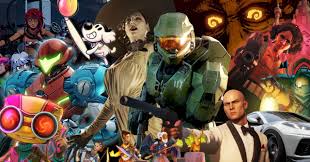The gaming industry has witnessed remarkable advancements in technology, storytelling, and player immersion over the past few decades. Among the most transformative changes has been the evolution of game animation, particularly in how characters are designed and brought to life. The expectations for game character realism, fluidity of movement, and emotional depth have drastically increased, pushing game studios in London to innovate and refine their character design services. In this article, we’ll explore the evolution of game animation, with a particular focus on character design and the role of leading game studios, including those in the UK, in shaping modern gaming experiences.
The Early Days of Game Animation
In the early days of gaming, character animation was relatively simplistic. Pixels were arranged in limited color palettes, and movement was often represented by a few frames, as seen in games like Pac-Man or Super Mario Bros. Characters were designed with minimal detail, and animation was often limited to walking, jumping, or basic attacks. However, even with these limitations, early games laid the groundwork for more complex animation to come.
The Impact of 3D Animation
The introduction of 3D animation was a pivotal moment for game development. Games like Tomb Raider and Final Fantasy VII in the mid-1990s showcased how three-dimensional environments and characters could elevate player engagement. Game studios began to invest heavily in creating characters that not only moved through space but interacted with their surroundings in more lifelike ways.
Game studios in the UK, in particular, became known for their innovative use of 3D technology. Studios like Rockstar North, known for Grand Theft Auto, pushed the envelope with their character animations, creating lifelike human movements and interactions. This shift allowed for greater narrative depth, as players became more emotionally invested in characters who felt more like real people.
The Rise of Motion Capture Technology
As gaming hardware became more powerful, so did the demands for realism in character animation. Motion capture (MoCap) revolutionized the way game characters were animated, allowing real actors’ movements to be captured and directly translated into the digital world. This advancement significantly improved character fluidity and authenticity in animation.
Leading game studios began using MoCap for everything from combat scenes to simple character interactions. In the game The Last of Us, for example, MoCap was critical in conveying the nuanced emotions of the main characters, making the experience highly immersive. By capturing the intricacies of human movement, developers could give characters personalities through their physical actions.
Procedural Animation and AI
In recent years, the incorporation of artificial intelligence (AI) and procedural animation has further evolved the field. Procedural animation allows for real-time adjustments to character movements based on player input or environmental factors, leading to more dynamic and responsive gameplay. AI-driven animation can create lifelike reactions and interactions that are otherwise difficult to pre-script.
This has given character design services the ability to create more adaptive characters, making the in-game experience more immersive. Games like Red Dead Redemption 2 are excellent examples of procedural animation at work, where characters react to weather, terrain, and other players in a highly realistic manner.
The Role of Character Design in Game Animation
At the heart of compelling animation is strong character design. Modern players expect characters that not only look good but move, interact, and behave in ways that are believable. From the initial concept art to final rendering, character design services are now an integral part of any game development process. They ensure that every aspect of a character—movement, appearance, and emotional expression—feels authentic.
In game studios, especially in the UK, the focus on creating deep and engaging characters has grown. Game studios in the UK have consistently demonstrated their ability to design iconic characters through attention to detail and innovative animation techniques. Whether it’s the gritty realism of the protagonists in Hellblade: Senua’s Sacrifice or the fantastical, highly animated creatures in Fable, these studios are at the forefront of character design and animation.
Blurring the Line Between Games and Films
Another noteworthy trend is the convergence of game animation with film-quality graphics and storytelling. Many of today’s game characters are so well-animated that they resemble those seen in animated movies. Game studios are increasingly partnering with character design services that specialize in high-end animation typically seen in the film industry. This has resulted in more cinematic game experiences, where players are not just controlling a character but are immersed in what feels like an interactive movie.
For example, games like Cyberpunk 2077 and Horizon Zero Dawn use animation techniques that rival Hollywood CGI. Characters in these games exhibit a level of facial expression, body language, and movement that brings them to life in ways previously unimaginable in gaming.
The Future of Game Animation and Character Design
Looking ahead, game animation will likely continue to evolve alongside emerging technologies such as virtual reality (VR), augmented reality (AR), and machine learning. These technologies offer the potential for even more immersive character interactions and greater levels of detail in character design.
As game studios in the UK and around the world continue to innovate, the role of character design services will become even more critical. Studios will need to balance the technical demands of animation with the artistic vision required to create characters that resonate with players on a deeper level. In an industry where player expectations are ever-growing, the future of game animation looks incredibly promising.
Conclusion
The evolution of game animation has come a long way from the pixelated sprites of the past to the highly detailed, lifelike characters we see today. Game studios and character design services are at the forefront of this transformation, continually pushing the boundaries of what’s possible in terms of visual fidelity and emotional depth.
In the future, the integration of new technologies like AI, VR, and MoCap will continue to shape the way characters are designed and animated. With game studios in the UK leading the charge, players can expect to see even more innovative and immersive character animations in the years to come, ensuring that gaming remains one of the most exciting and dynamic forms of entertainment.
By focusing on character design services, game studios can continue to captivate audiences, creating worlds filled with characters that are not only visually stunning but also emotionally engaging and highly interactive.



